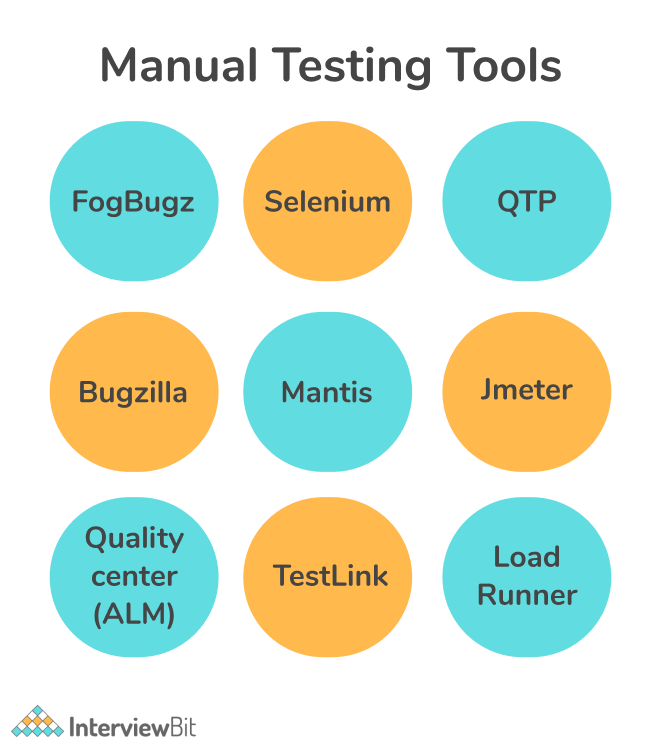Manual testing is a kind of software testing in which test cases are executed manually rather than using an automated tool. The tester manually runs all test cases from the viewpoint of the end-user. It determines whether or not the application meets the requirements specified in the requirement document. To finish almost 100% of the software application, test cases are created and implemented.
Manual testing is one of the most basic testing methods since it may detect both obvious and hidden software flaws. A fault is a discrepancy between the intended output and the output provided by the program. The developer corrected the flaws before handing them over to the tester to re-test.
Before automated testing, any newly generated software or product must undergo manual testing. This testing takes a lot of time and work, but it ensures that the product is bug-free. Manual testing requires familiarity with manual testing procedures but not with automated testing software.
Confused about your next job?
What is the Importance of Manual Testing?
Increasingly, software professionals favor automated testing, although there are still many reasons for manual testing. Few are:
- Human Perspective: Humans can simply glance and assess the application’s fundamental usefulness and appearance. When a tester interacts with software in the same way that a user would, they might identify usability difficulties and user interface flaws. Automated test scripts are incapable of detecting these issues.
- A larger view of the System workflows: Manual verification always provides a wider view of the app. The human mind is constantly in an exploring mode, not a coding one that repeats processes. So, it will cover the greater ground for system validation.
- Cost of automation: often Automated testing may generate false positives and negatives. These mistakes are prevented by including a human touch throughout the testing procedure.
Scenarios that aren’t automatable or don’t offer obvious confidence in user behavior when testing with automation, for example, “Tap & Pay” on mobile devices, have distinct behaviors when automated using tools vs. manually verified. Despite this, manual testing has retained its position in the fast-paced software development cycle’s validation phase. Moreover, in certain circumstances, manual verification is the best option. So, what are the manual testing tools?
Top Manual Testing Tools
Here is the list of top 10 manual testing tools along with its features:

1. LoadRunner
It’s one of the most widely used performance testing tools. The primary purpose of LoadRunner is to provide performance testing for a wide variety of methods, methodologies, and application settings.The LoadRunner program’s primary goal is to categorize the most prevalent causes of performance problems rapidly.
Features
- The LoadRunner is compatible with a wide variety of development tools, technologies, and protocol stacks.
- Using the LoadRunner program, we can generate detailed performance test data.
- It will lower the cost of distributed load testing and provide an operational tool for tracking deployments.
2. Citrus
Citrus is a tool for integrating testing, and it is the most often used test framework. Java is the programming language used to create it. It’s usually used to send and receive server-side and client-side requests and verify XML JSON files. In addition, citrus supports many HTTP, JMS, and SOAP protocols for end-to-end use case testing.
Features: It’s solution. citrus It
- All surrounding interface partners are emulated independently of their transport protocols (Http, JMS, TCP/IP, SOAP, and several more).
- Citrus may incorporate the tests into a continuous integration environment, ensuring that credit for software quality is given at all times.
3. ZAP
ZAP is a web application security scanner that is free and open-source.The ZAP is the acronym for Zed Attack Proxy. It is developed in the JAVA programming language, much like several other utilities. It’s one of the most successful Open Web Application Security Projects [OWASP].OWASP ZAP is a tool for doing dynamic application security testing (DAST) on web applications.
ZAP’s features
- It works with a variety of operating systems, including Windows, Linux, and OS X.
- Its architecture is plugin-based.
- It has an online marketplace where we may buy and sell new and updated features.
- The GUI control panel for ZAP is simple to use.
4. NUnit
NUnit is one of the most widely used unit testing frameworks. It is an open-source tool that is based on the JUnit framework. It was created entirely in the C# programming language and is acceptable for everyone. In other words, the NUnit tool has been completely revamped to benefit a wide range of users.
NUnit’s Features: assertions.
- It keeps the data-driven experiments going.
- It is compatible with various platforms, including.NET core, Xamarin mobile, Silverlight, and an efficient framework.
- The capabilities of NUnit allow us to run several tests at the same time.
- The tests are loaded and executed using a console runner.
5. JIRA
It is a manual testing tool that connects directly with code development environments, which makes it ideal for developers as well. Because it is capable of tracking almost any kind of problem, it is not limited to the software sector. It is compatible with agile projects.
JIRA’s Features device. project, It’s, of
- With JIRA Query Language, you can quickly define filters with a single click.
- It is possible to construct bespoke processes of any size, which is beneficial for software development, testing, and release.
- Install plug-and-play add-ons from The Atlassian Marketplace to accommodate a variety of scenarios
6. SonarQube
SonarQube is another manual testing tool that helps our productivity by maintaining code quality and security. Moreover, it is adaptable thanks to the usage of plug-ins.It is written entirely in the JAVA programming language. It supports Ant, Maven, Gradle, MSBuild, and other continuous integration technologies for completely automated review and integration. In addition, SonarQube can keep track of measurements over time and provide an evolution graph.
Sonarqube’s features
- C, C++, Python, JAVA, HTML, CSS, VB.NET, PHP, COBOL, PL/SQL, and more programming languages are supported.
- Sonarqube is available for free under the GNU Lesser General Public License.
- SonarQube is linked to several major third-party applications, including GitHub, Active Directory, LDAP, and others.
- Because of the SonarLint plug-ins, SonarQube has integrated with the Visual Studio, Eclipse, and IntelliJ IDEA development environments.
7. JMeter
JMeter is an open-source tool for testing the performance of static and dynamic resources and dynamic web applications. It is based entirely on the JAVA application and is used to load functional test behaviour and assess application performance. It makes it easier for consumers or developers to utilize the source code to create new apps.
JMeter’s Features
- It is platform-agnostic, accepting JVMs from Windows, Mac OS X, Linux, and other platforms.
- It has an easy-to-use, engaging, and clear user interface.
- You may load the performance test on a variety of servers, which makes it quite versatile.
8. Bugzilla
Bugzilla is another issue tracking application that is utilized in manual testing. It is commonly used by many businesses to monitor the application’s numerous issues.Bugzilla is an open-source application that assists customers and clients in keeping track of issues. Bugzilla is also a test management tool since it allows us to quickly connect other test case management solutions like ALM, Quality Center, and others.
Bugzilla’s Features wor We You a
- It has a simple-to-use Google-style bug search that also searches the complete text of a bug.
- It has a very powerful search mechanism that enables you to build any sort of search you choose, including time-based searches.
- You will get an email notice whenever any changes are made to the Bugzilla, and the alerts you receive based on which issue are completely customizable through the user options.
9. Mantis
Mantis is a manual testing tool for tracking down bugs or faults in a system or piece of software. Users may readily tweak it to their specifications. Compatible with a variety of operating systems, including Windows, iOS, Android, and iPhone. Mantis includes a number of plugins that allow you to extend the functionality of the mantis issue tracker. It has email notification tools that enable it to send emails to linked stakeholders with updates, comments, and resolves.
Mantis Features: We ChangesIt Text
- MantisBT is a free and open source issue tracker that strikes an ideal blend of simplicity and capability.
- Users may get started in minutes and immediately begin managing their projects while efficiently working with their peers and customers.
- Access control for users depending on their roles within a project, giving you control of your company.
10. Tessy
Tessy is another integration testing solution for embedded software used to do the integration and unit testing. It also assists us in determining the program or application’s code coverage. It can handle the full test organization with ease, including business requirements, test management, coverage amount, and traceability.The following are the three major roles of Tessy: Workspace for the Test Interface Editor (TIE) and the Test Data Editor (TDE).
TESSY’s Manual Testing Features
- It generates a test report based on the outcomes of the test execution.
- It works with a variety of programming languages, including C and C++.
- Tessy is used to assessing the function’s interface and to explain the variable that the function uses.
11. TestLink
TestLink is a high-quality product since it packs more functions into a comparable package. It has gained significant attention as a result of the success of its web-based software testing method. Software quality assurance is a critical part of the software testing process. Thus, it is critical to tailor a set of testing procedures to the requirements.
Features:
- TestLink provides a variety of assistance options for different.
- Due to its web-based capabilities, it is one of the most user-friendly programmes.
- It is simple to use since the programme is available through a browser connected to the internet.
12. Trac
Trac is one of the most powerful manual testing tools available, and it is developed in Python. It is a web-based programme and is not guaranteed to be a specialised tracking system. However, if your SCM system is integrated with Trac, you may navigate through view history, code, and changes. Additionally, all problems in the tool are referred to as tickets, which creates a ticket management system for debugging faults. As a consequence, tickets may also be resolved at a later time.
Features:
- Trac is a simple project management tool created in the Python computer language. It is implemented as a web-based application.
- It is compatible with a variety of databases, including SQLite, MySQL, PostgreSQL, and MS-SQL.
- It is sufficiently adaptable to a variety of project kinds. Because it is open source, you can always modify it yourself, build plugins, or hire someone else to do so to better suit your project’s requirements.
13. ALM (Application Lifecycle Management)
ALM (Application Lifecycle Management) is another high-quality tool that HP owns. Mercury Interactive Corporation developed the product that was recently bought by HP and has been providing high-quality services ever since.
Each user should consider utilising the appropriate programme in order to get quick results. ALM is a quality tool that is often used in the IT and application development industries. ALM has a sizable user base in light of its features for quite some time now.
Features:
- Before an application is established, application lifecycle management establishes a clear direction for it.
- Additionally, ALM enables firms to make more informed choices as their software matures. Team leaders may swiftly and firmly sketch out an app’s future using capabilities such as version control and real-time planning (available in many ALM products).
14. Sikuli
Sikuli is a free image-based automated testing tool that takes a visual approach to desktop items. By recognising the appearance of buttons, shortcuts, or links, the tool detects them and captures a portion of the screen as the active area. Sikuli is ideal for testing desktop programmes and for situations when you cannot simply access the source code for the graphical user interface.
Features:
- Sikuli is capable of automating the creation of Flash Objects / Flash Websites.
- It is sometimes advantageous to automate Window-based applications. We can automate the display of what we see on the screen.
- It offers a straightforward API. That is, all methods are accessible through screen class objects.
- It integrates well with Selenium and all other technologies.
15. Jenkins
Jenkins is an ideal open-source quality assurance tool for continuous integration. We use it frequently: when a build is published, the tests begin automatically running. What we enjoy about Jenkins is the active community support and the large variety of plugins that enable developers and testers to work more efficiently.
Features:
- Jenkins is a platform-independent, self-contained Java application that is packaged for Windows, Mac OS X, and Unix-like operating systems.
- Jenkins is simple to install and setup using its web interface, which includes error checking and an integrated help feature.
- The Update Center has hundreds of plugins that integrate with every tool in the continuous integration and continuous delivery toolchain.
Conclusion
With the increased demand for software testing tools and the increased interest in manual testing due to its ability to efficiently trace bugs and defects, one must look for a tool that is not only simple to use and has an intuitive interface, but also includes a test management system, test planning and execution capabilities, and bug trackers. Hopefully, the Manual testing tools in this article will help you in the software testing industry.
ols, along with their features, will help you in the software testing industry.
FAQs
Q1: What are manual testing tools?
Ans: Manual Testing is a subset of software testing in which test cases are manually run by a tester without the use of automated technologies. Manual testing is used to locate bugs, faults, and flaws in a software product. The tools which are used in this process are known as manual testing tools such as Bugzilla, JIRA, JMeter, and many more.
Q2: Is Jira a testing tool?
Ans: Yes, JIRA is a testing tool. JIRA is a bug tracking tool that is primarily used to monitor, categorize, and prioritize problems, new features, and enhancements for specific software versions. Projects are separated into problems, which may take on a variety of forms, including bugs, new features, enhancements, and documentation assignments.
Q3: What is a manual testing example?
Ans: Testing a piece of software’s end-to-end flow. You should perform acceptance testing on a real estate application that is an example of manual testing, allowing users to input images and produce real estate listings.
Q4: How do I start QA testing?
Ans: It generally begins with appointing a senior quality assurance specialist and forming a quality assurance team. Here are the stages to start the QA testing:
Stages of Quality Assurance Process
- Examine the specifications.
- Make a test schedule.
- Create the tests.
- Tests must be completed, and defects must be reported.
- You should perform Re-Tests and Regression Tests.
- Carry out Release Testing.
Additional Resources
- Software Testing MCQ
- Testing Tools
- Automation Testing Tools
- API Testing Tools
- Performance Testing Tools
- Automation Testing Interview Questions
- Selenium Interview Questions
- Software Testing Interview Questions
- Principles of Software Testing
- Difference Between Testing and Debugging
- Difference Between Alpha and Beta Testing







 Join WhatsApp Group
Join WhatsApp Group


